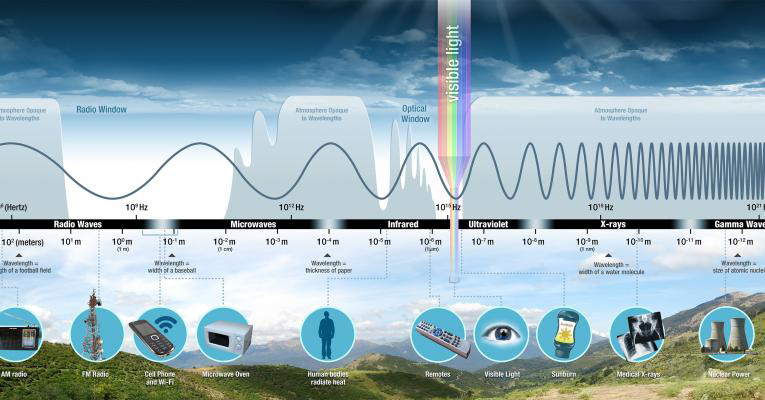Expanded from question two of the big three heliophysicist investigative questions: How do the Earth, the solar system, and heliosphere respond to changes on the Sun? Learn more ›
Electromagnetic energy travels in waves and spans a broad spectrum from very long radio waves to very short gamma rays. The human eye can only detect only a small portion of this spectrum called visible light. A radio detects a different portion of the spectrum, and an x-ray machine uses yet another portion. NASA's scientific instruments use the full range of the electromagnetic spectrum to study the Sun, Earth, the solar system, and the universe beyond. When you tune your radio, watch TV, send a text message, or pop popcorn in a microwave oven, you are using electromagnetic energy. You depend on this energy every hour of every day. Without it, the world you know could not exist.

Best Practice! Using Guiding Questions to Drive Inquiry
Each big idea has student-friendly questions written at different levels that you can use to guide inquiry-based investigations at the appropriate level. Explore this big idea at each level below, with featured resources you can engage learners with.
Introductory Learner
Guiding Question: Where do you find invisible light?
Standards: PS3, PS4
Heliophysics Narrative:
- Human eyes can see visible light and the objects that are illuminated by this light. Visible light is only a very small part of the electromagnetic (EM) spectrum. Scientists call the light we can’t see “invisible” light, but they have special equipment to "detect" it, including special cameras and telescopes. Invisible light is all around us. Infrared light is experienced as heat. We can feel ultraviolet (UV) light when we get a sunburn. Do you have a microwave? Have you gotten an x-ray? Do you use bluetooth devices? Bluetooth are radio waves, which is also invisible light!
- At this level students may have seen representations of the EM spectrum, and are most likely familiar with many forms of invisible light: infrared, UV, x-rays, and microwaves, but the standards don't support much exploration into EM radiation, other than visible light (1-PS4-2). But by grade 4 they begin to see light as energy (4-PS3-2) and can quantify a wave's energy by its properties, i.e. wavelength and amplitude (4-PS4-1).
- Connect to the Sun by emphasizing that the Sun is the primary source of light in our solar system, and that it, in fact, emits visible light and invisible light (remind students of wearing sunscreen to protect their skin from UV). The Moon gives off invisible light, but the only time we can see the Moon is when the Sun's visible light is reflecting off of it. Each type of light on the EM spectrum has a different wavelength and amplitude. This determines the energy that the light carries. Light with short wavelengths (x-rays) have more energy than light with longer wavelengths (radio).
- Extend student exploration with discussion of radio waves. Students are most familiar with radios making sound. Radio waves are light waves and sound waves are pressure waves; they are different. The radio you listen to is a device that converts the radio waves (the signal) into sound waves. The radio amplifies the energy in the radio waves and uses it to vibrate the speaker, which produces pressure changes in the air that vibrate your eardrum. Remember that while sound waves need a medium to travel through, like air, light waves do not and can travel through a vacuum.
- Support beginners by guiding them through their observations of invisible light. Playing with invisible ink and "black lights" is also an effective way to get students to think about invisible light.
- Challenge students at the next level by examining images from NASA missions that take pictures in different wavelengths of light. Remember that color is visible light. So when scientists examine images taken in invisible light, they need to add color to the images in order to see the features. Specific colors are chosen to help scientists observe patterns in the data.
Featured Resource: Sun as a Star: Science Learning Activities for Afterschool, Grades 5-12 ›
Intermediate Learner
Guiding Question: How does light travel?
Standards: PS2, PS4
Heliophysics Narrative:
- Light travels as a wave in a repeating pattern with a specific wavelength, frequency, and amplitude, and with constant speed. Unlike sound and water waves, light does not need any matter to carry its energy so it can travel through a vacuum, like space. When light shines on an object, it is reflected, absorbed, or transmitted through the object, depending on the object's material and the frequency of the light.
- At this level, students come to understand light as electromagnetic radiation, and that it travels through space as a wave (MS-PS4-2). Students are able to identify how the properties of waves relate to color and the amount of energy the wave transfers (frequency) (MS-PS4-1, 2). Students experiment with how light interacts with different materials (MS-PS2-2).
- Connect to the Sun by having students think about how one photon of light starts at the core of the Sun and travels out through all of the layers of the Sun (which can take several tens of thousands of years) and then travels through space to Earth (8 minutes). Ask students what would happen when a light wave encounters something that reflects the light (like the Moon), absorbs the light (chloroplasts in plants), or that the light passes through (Earth’s atmosphere).
- Extend student exploration of light by having students investigate how light is used to communicate information through digital signals (MS-PS4-3).
- Support beginner learners by giving them more opportunities to experiment with light and how it interacts with different materials (PS4).
- Challenge students at the next level by having them investigate what a light year is. Scientists can identify how far objects are away from Earth based on how long it takes for the light from that object to reach Earth. This could be the light from a distant star, or the reflection of light off a planet or a moon. The more distant the object, the longer it takes for the light to travel. That is why a "light year" is a unit of distance, not time, which is a common misconception.
Featured Resource: Astronomer's Toolbox: Spectroscopes ›
Advanced Learner
Guiding Question: How does light teach us about distant objects thousands of light years away?
Standards: PS1, PS4, ESS1
Heliophysics Narrative:
- We learn about distant planets, stars, and galaxies by their light, captured by ground-based and space telescopes. Light is produced when atoms are excited, their electrons jump energy levels, and when they fall back to their original ground state, they release photons (particles of light). Depending on the type of element the atom is, the characteristic of that light changes. Each element generates its own unique set of wavelengths of light emission or light absorption. We can use these patterns of emission and absorption, like fingerprints, to allow identification of the presence of an element, even in microscopic quantities, on a distant object. This is called spectroscopy, and it is a critical tool that astronomers use every day.
- At this level, students learn that EM radiation can be represented by a particle model (HS-PS4-3), which helps explain how atoms create photons. Students learn about how light spectra are used to identify compositional elements of stars (HS-ESS1-2,3)(HS-PS1-1).
- Connect to the Sun by emphasizing that scientists use our understanding of the Sun and the solar system to try to find other places in the galaxy where life could exist. They use spectroscopy to look for evidence of the key elements needed for life. For example, scientists can use spectroscopy to identify the composition of the atmosphere of an exoplanet by analyzing the starlight being filtered through the planet's atmosphere.
- Extend student exploration by having them compare the composition and processes of our star, the Sun, to how other stars behave and how those stars affect their planetary systems.
- Support beginner students by examining the spectra of different kinds of elements.
- Challenge students at the next level to examine data from Parker Solar Probe about the composition of the Sun, and compare that to the data the James Webb Space Telescope has gathered on the atmospheres of nearby exoplanets.
Featured Resource: Exploring Light with the Hubble Space Telescope ›
What level are my learners?
Introductory: A younger learner (K-5), or a learner new to the subject matter.
Intermediate: A middle-aged learner (6-8), or a learner that has some familiarity with the subject matter.
Advanced: An older learner (9-12+), or a learner that has a lot of experience with the subject matter.
Note: Next Generation Science Standards (K-12) are mapped to the resources accordingly.
What is a NGSS Heliophysics Narrative?
NGSS Heliophysics Narratives support educators with the incorporation of heliophysics concepts and resources into their existing curricula. The narratives consist of relevant heliophysics background information, applicable NGSS performance expectations, and guiding questions to spark inquiry-based learning at the appropriate level.
Narrative Structure:
- Short answer to the question, for teacher background knowledge
- An analysis of NGSS Performance Expectations (PE) to determine learning constraints at each level
- Heliophysics topics that connect to the NGSS PE and can be infused into teaching systems science
- More heliophysics to explore
- How to support beginner learners
- How to challenge learners at the next level





